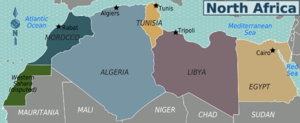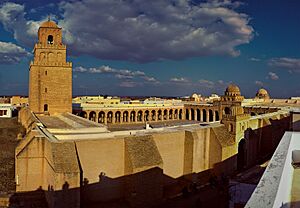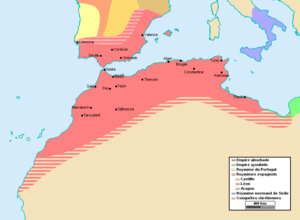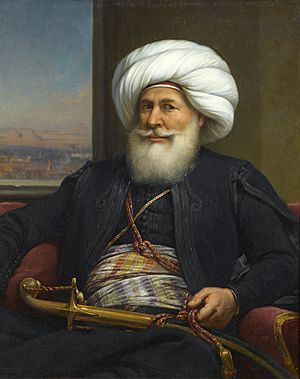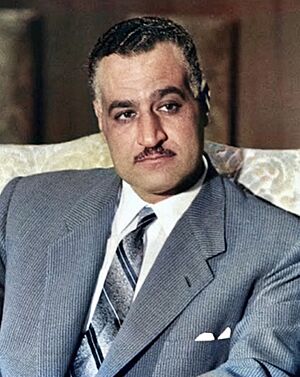History of North Africa facts for kids
The history of North Africa is like a long story with many chapters. It covers ancient times, the arrival of Islam, the period when European countries took control, and finally, when the countries we know today became independent. This region has been shaped by many different cultures. When people learned to travel by sea, North Africa became closely connected to the Mediterranean world, especially during ancient times. Later, the Sahara became important for trade too. Camel caravans carried goods and people from areas south of the Sahara. North Africa also has a small but important land link to the Middle East, which has also played a big role in its history.
Contents
- Geography: Where is North Africa?
- Climate: How the Weather Changed
- Prehistory: The Earliest People
- Arrival of Islam: A New Era
- Abbasid Rule and Local Dynasties: New Rulers Emerge
- Muslim Berber Empires: Strong Local Powers
- Ottoman Rule: A New Imperial Power
- European Colonial Period: Foreign Control
- Europe and the Maghreb: Economic Connections
- Post-Colonial Period: Independence and New Challenges
- Images for kids
Geography: Where is North Africa?
North Africa is a narrow strip of land. It sits between the huge Sahara desert and the Mediterranean Sea. This area stretches from the Atlantic coast of Morocco all the way to Egypt. There isn't one exact definition for North Africa, but it usually includes Morocco, Algeria, Tunisia, Libya, and Egypt. South of the desert is a drier area called the Sahel. This is a transition zone between the desert and the greener Sudanian Savanna further south.
Climate: How the Weather Changed
Long ago, around 15,000 years before today, the weather in West Africa changed a lot. This led to a period called the Green Sahara. During this time, North Africa received much more rain in the summer. This created many lakes and wetlands, and the land became covered in grassland and shrubland. But between 5,500 and 4,000 years ago, the Green Sahara period ended, and the region became dry again.
Prehistory: The Earliest People
The first known humans lived in North Africa about 260,000 years ago. For most of the Stone Age, the climate was very different. The Sahara was much wetter and looked more like a savanna. Large mammals lived there, supporting many hunter-gatherer groups. The Aterian culture, which developed here, was one of the most advanced societies of the Paleolithic (Old Stone Age).
In the Mesolithic period (Middle Stone Age), the Capsian culture was strong in eastern North Africa. By 6,000 BC, Neolithic farmers became common. During this time, the Sahara slowly became drier. This created a natural barrier between North Africa and the rest of Africa.
Around 10,000 years ago, people started creating amazing Saharan rock art. This included engraved and painted images that tell stories of different periods.
The Nile Valley in eastern North Africa is one of the best places for agriculture in the world. As the Sahara dried up, more people moved to the Nile Valley. This led to the growth of large cities. Eventually, ancient Egypt became one of the world's first great civilizations.
Bronze and Iron Age: Early Civilizations
The vast Libyan Desert separated Egypt from the rest of North Africa. Egyptian boats were good for the Nile but not for the open Mediterranean Sea. So, Egyptian traders mostly focused on places like Crete, Cyprus, and the Levant (the eastern Mediterranean coast).
Later, Greeks from Europe and Phoenicians from Asia also settled along the North African coast. Both groups were successful because of sea trade. They didn't find many trading chances with the local people, so they started building colonies. The Greeks mainly traded in the Aegean, Adriatic, Black, and Red Seas. They built major cities only in Cyrenaica, south of Greece. In 332 BC, Alexander the Great conquered Egypt. For the next three centuries, Egypt was ruled by the Greek Ptolemaic dynasty.
The Phoenicians had an even bigger presence in North Africa. They built colonies from Tripoli all the way to the Atlantic. One of their most important cities was Carthage. Carthage grew into a powerful empire, controlling the western Mediterranean and most of North Africa outside of Egypt. However, Rome, Carthage's main rival, defeated it in a series of wars called the Punic Wars. Carthage was destroyed in 146 BC, and Rome took over its empire. In 30 BC, the Roman Emperor Octavian conquered Egypt. This was the first time the entire North African coast was united under one ruler.
Carthage had reached deep into the Sahara, keeping the nomadic tribes there peaceful. The Roman Empire mostly stayed along the coast. They often took land from the Berber people for Roman farmers. This meant they faced constant threats from the south. The Romans built a network of forts and walls on their southern border. This helped secure the region enough for local soldiers to control it without much help from the main Roman Empire.
When the Roman Empire started to fall apart, North Africa was mostly safe until the Vandal invasion in 429 AD. The Vandals ruled North Africa until the Eastern Roman Empire, led by Justinian, took back the lands in the 6th century. Egypt was never invaded by the Vandals because it was protected by a thousand miles of desert and had stronger defenses.
During the rule of the Romans, Vandals, Byzantines, Carthaginians, and Ottomans, the Kabyle people managed to stay independent. Even after the Arab conquest of North Africa, the Kabyle people kept control of their mountains.
Arrival of Islam: A New Era
Arab Conquest: Spreading a New Faith
In the 7th century CE, the start of Islam brought together many nomadic Arab tribes. This new faith stopped their old fights over religious differences. The main goal of the early Muslim armies was to spread Islam and convert people who didn't believe in one God. They were also tolerant of people who followed other monotheistic or Abrahamic religions.
Led by brilliant generals, the new Rashidun Caliphate, based in Medina, won important battles against the powerful empires of the Middle East. They expanded in all directions. The Byzantine Empire was already tired from previous wars, so they left Syria in 636 CE after only two years of fighting.
With the Byzantine power in the region broken, the Muslim armies moved towards Egypt. By 642 CE, they had conquered all of Egypt after the siege of Alexandria. They usually faced little resistance because many people disliked Roman rule. The quick spread of Islam in Egypt happened partly because people were unhappy with the Chalcedonian schism, a religious split. Moving up the Nile, the Muslims attacked the Makurians but were defeated in the first battle. This was a rare loss for the Muslims, due to the skilled Nubian archers and natural defenses.
Their attention then turned west to the Maghreb region. The Exarchate of Africa had declared independence from Constantinople under Gregory the Patrician. The Muslims easily took over Ifriqiya (modern-day Libya). In 647 CE, they decisively defeated and killed Gregory and his army in battle. The Muslims didn't want to take over the whole area right away. Instead, they raided the weakened state. The people, seeing they were at the Muslims' mercy, agreed to pay a large tribute, which was accepted. The Rashidun armies returned to Egypt. They invaded Makuria again in 652 CE but were defeated once more. This led them to sign a treaty that brought peace. This treaty shaped relations between Egypt and Nubia for over seven centuries.
Further expansion into North Africa paused for twenty years because of the First Fitna, a civil war. This led to the creation of the Umayyad Caliphate, which moved the capital of the Muslim empire to Damascus. In 670 CE, Uqba ibn Nafi al-Fihiri invaded what is now Tunisia. He wanted to take the region from the Byzantine Empire, but he was only partly successful. He founded the town of Kairouan. He was replaced by Abul-Muhajir Dinar in 674 CE. Abul-Muhajir successfully moved into what is now eastern Algeria. He brought the Kingdom of Altava and the Awraba tribe, both ruled by Kusaila, into the Islamic world.
In 681 CE, Uqba was given command of the Arab forces again. He advanced westward in 682 CE, holding Kusaila as a hostage. He reached the Atlantic Ocean in the west and went into the Draa River Valley and the Sus region in what is now Morocco. However, Kusaila escaped during the campaign. He attacked Uqba on his way back and killed him near Biskra in what is now Algeria. After Uqba's death, the Arab armies left Kairouan, which Kusaila then made his capital. He ruled there until an Arab army under Zuhair ibn Kays defeated him. This made the Berbers realize that this conflict was not just against the Byzantines. Zuhair himself was killed in 688 CE while fighting the Byzantine Empire, which had taken back Cyrenaica while he was busy in Tunisia.
In 693 CE, Caliph Abd al-Malik ibn Marwan sent an army of 40,000 men, led by Hasan ibn al-Nu'man, into Cyrenaica and Tripolitania. Their goal was to remove the Byzantine threat to the Umayyads' advance in North Africa. They faced no resistance until they reached Tunisia. There, they captured Carthage and defeated the Byzantines and Berbers near Bizerte.
Soon after, al-Nu'man's forces fought against the Kingdom of the Aures and the Jrāwa tribe, both led by their queen, Al-Kahina. The Berbers defeated al-Nu'man in two battles. The first was on the Nini River, and the second was near Gabis. After these defeats, al-Nu'man's forces went back to Cyrenaica to wait for more soldiers. For five years, Al-Kahina was the unchallenged ruler of the Maghreb. Then, Arab reinforcements arrived in 703 CE, and al-Nu'man advanced into what is now Tunisia. He met Al-Kahina again near Gabis. This time, he won. Al-Kahina retreated to Tubna, where her forces were defeated, and she was killed.
Al-Nu'man then took back Carthage from the Byzantines, who had retaken it when he left Tunisia. He founded the city of Tunis nearby and used it as a base for the Ummayad navy in the Mediterranean Sea. The Byzantines had to leave the Maghreb and retreat to the islands of the Mediterranean Sea. However, in 705 CE, al-Nu'man was replaced by Musa bin Nusair. Nusair attacked what is now Morocco, captured Tangier, and advanced to the Sus river and the Tafilalt oasis in a three-year campaign.
Kharijite Berber Rebellion: A Fight for Control
After the Arab conquest, some Berber groups, especially those following the Kharijite branch of Islam, rebelled against the Umayyad rulers. This was known as the Berber Revolt.
Abbasid Rule and Local Dynasties: New Rulers Emerge
The Umayyad Caliphate was overthrown in the east by the Abbasid Revolution, which created the Abbasid Caliphate. The Abbasids took control of Egypt and central North Africa, as far west as Ifriqiya. However, the regions further west remained outside their direct control. These western areas were ruled by local Berber tribes or other local dynasties. These groups often followed either Sufri or Ibadi Kharijism.
Aghlabids: Rulers of Ifriqiya
The Aghlabids were a dynasty that ruled Ifriqiya (modern Tunisia and parts of Algeria and Libya) on behalf of the Abbasid Caliphate from 800 to 909 CE. They were known for their strong navy and for conquering Sicily.
Fatimids: A Powerful New Caliphate
The Fatimid Caliphate was started by Abu Abdallah al-Shi'i with help from the Kutama Berbers. They conquered Ifriqiya from the Aghlabids. In 909, Abdallah al-Mahdi became the first Fatimid Caliph in Ifriqiya. They expanded their control over Egypt, parts of the Maghreb, Sicily, the Levant, and the Hijaz. In 969, the Fatimid army conquered Egypt. In 973, the Fatimid court moved to their new capital, Cairo. The Zirids were left to govern the Maghreb. After a long period of decline, the Fatimid Caliphate was finally ended by Salah ad-Din in 1171. He replaced them in Egypt with the Ayyubid dynasty.
Muslim Berber Empires: Strong Local Powers
Zirids: Ruling the East
The Zirid dynasty was a family of Sanhaja Berbers from the Kabyle mountains. They first ruled the eastern and central Maghreb for the Fatimids. However, they faced more resistance in the west from other Berber groups and the Umayyads of Cordoba. Between 1041 and 1051, they stopped recognizing the Fatimid caliphs in Cairo. The Fatimids responded by sending the Banu Hilal and Banu Sulaym tribes to invade the Maghreb.
Hammadids: A Separate Berber Kingdom
The Hammadid dynasty came to power after declaring their independence from the Zirids in 1015. They managed to conquer land across the Maghreb region. They held important cities like Algiers, Bougie, Tripoli, Sfax, Susa, Fez, Ouargla, and Sijilmasa. South of Tunisia, they also controlled several oases that were important stops on trans-Saharan trade routes.
Almoravids: A Religious Movement and Empire
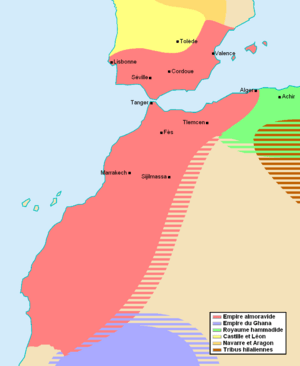
In the 11th century, Berber groups from the Sahara started a jihad (holy struggle) to reform Islam in North Africa. They wanted to follow a stricter version of Maliki Islam. This movement was inspired by the teachings of Ibn Yasin. They officially recognized the Abbasid Caliphs as their leaders. This movement created a large empire. At its biggest, it included Al-Andalus (parts of southern Iberia) and most of modern-day Morocco and Western Sahara. This movement helped spread Islam further south into Africa. The Almoravids are also traditionally believed to have attacked and caused the fall of the West African Ghana Empire. However, some historians now question this idea.
Almohads: Another Powerful Berber Dynasty
The Almohads were another religious and political movement that started among the Berbers in the western Maghreb during the 12th century. They promoted a new, very strict and reformist version of Islam. They believed Ibn Tumart was a special leader, the Mahdi. After Ibn Tumart's death, 'Abd al-Mu'min took over the political leadership. He overthrew the Almoravids and conquered the entire Maghreb and the remaining parts of Al-Andalus. Their empire broke apart in the 13th century. It was replaced by three main states in North Africa: the Marinids in the western Maghreb, the Zayyanids in the central Maghreb, and the Hafsids in the eastern Maghreb (Ifriqiya).
Hafsids: Rulers of Ifriqiya
The Hafsid dynasty was a Berber family that ruled Ifriqiya (modern Tunisia) from 1229 to 1574. At their strongest, their lands stretched from eastern Algeria to western Libya.
The dynasty was named after Muhammad bin Abu Hafs, a Berber from the Masmuda tribe of Morocco. He was made governor of Ifriqiya by Muhammad an-Nasir, a Caliph of the Almohad empire. The Banu Hafs were a powerful group among the Almohads. Their ancestor, Omar Abu Hafs al-Hentati, was a close friend of Ibn Tumart.
The Hafsids, as governors for the Almohads, constantly faced threats from the Banu Ghaniya. These were descendants of the Almoravid princes whom the Almohads had defeated.
The Hafsids declared independence from the Almohads in 1229. Under Abu Zakariya (1229–1249), they organized the government in Ifriqiya and made Tunis a major economic and cultural center. Many Muslims from Al-Andalus (Spain), who were fleeing the Spanish Reconquista, settled in Hafsid lands. Abu Zakariya also conquered Tlemcen in 1242 and made the Abdalwadids his vassals. His successor, Muhammad I al-Mustansir (1249–1277), took the title of Caliph.
In the 14th century, the empire weakened for a while. Although the Hafsids managed to control the Kingdom of Tlemcen for a time, they were twice conquered by the Merinids of Morocco between 1347 and 1357. However, the Abdalwadids couldn't defeat the Bedouin tribes, and eventually, the Hafsids regained their empire. During this same period, outbreaks of the plague caused a big drop in population, further weakening the empire.
Under the Hafsids, trade with Christian Europe grew a lot. However, piracy against Christian ships also increased, especially during the rule of Abd al-Aziz II (1394–1434). The money from this was used for big building projects and to support art and culture. But piracy also led to attacks from Aragon and Venice, who sometimes attacked Tunisian coastal cities. Under Utman (1435–1488), the Hafsids reached their peak. Trade routes through the Sahara and with Egypt developed, as did sea trade with Venice and Aragon. However, the Bedouins and many cities in the empire became largely independent, leaving the Hafsids in control of only Tunis and Constantine.
In the 16th century, the Hafsids got caught up in the power struggle between Spain and the Ottoman Empire-supported Corsairs. The Ottomans conquered Tunis in 1534 and held it for one year. Because of the Ottoman threat, the Hafsids became vassals of Spain after 1535. The Ottomans conquered Tunis again in 1569 and held it for four years. Don Juan of Austria recaptured it in 1573. The Ottomans finally conquered Tunis in 1574. The Hafsids accepted becoming a Spanish vassal state to try and stop the Ottoman threat. Muhammad IV, the last Hafsid Caliph, was taken to Constantinople and later executed. This was because he worked with Spain and because the Ottoman Sultan wanted to take the title of Caliph, as he now controlled Mecca and Medina. A branch of the Hafsid family survived by being taken to the Canary Island of Tenerife by the Spanish.
Ottoman Rule: A New Imperial Power
After the Middle Ages, North Africa was generally under the control of the Ottoman Empire. However, the Kabyle people and the Moroccan region, ruled by the Saadi Sultanate, remained independent. Ottoman rule was mainly focused on the cities of Algiers, Tunis, and Tripoli.
European Colonial Period: Foreign Control
During the 18th and 19th centuries, North Africa was colonized by France, the United Kingdom, Spain, and Italy. In the 1950s, 1960s, and into the 1970s, all the North African states gained independence from their European rulers. The only exceptions were a few small Spanish colonies on the northern tip of Morocco, and parts of the Sahara region, which later went from Spanish to Moroccan rule.
In modern times, the Suez Canal in Egypt, built in 1869, caused a lot of discussion. The Convention of Constantinople in 1888 declared the canal a neutral zone. It was protected by the British, who had moved troops there in 1882. Under the Anglo-Egyptian Treaty of 1936, the United Kingdom insisted on keeping control over the canal. In 1951, Egypt rejected the treaty, and by 1954, Great Britain agreed to leave.
After the United Kingdom and the United States stopped their promise to help build the Aswan Dam, President Gamal Abdel Nasser took control of the canal for Egypt. This led Britain, France, and Israel to invade in the week-long Suez War. Because of damage and sunken ships, the canal was closed until April 1957. It was cleaned up with help from the UN. A United Nations force (UNEF) was created to keep the canal and the Sinai Peninsula neutral.
Europe and the Maghreb: Economic Connections
In the 1960s, the European Economic Community (which later became the European Union) started to build economic and social relationships with the Maghreb states. The Treaty of Rome invited Morocco and Tunisia to create an agreement with the EEC. This helped Maghreb nations trade with Europe and influenced their growth. Trade between Europe and the Maghreb slowly increased, leading to the creation of the Global Mediterranean Policy in 1972. This policy lasted until 1992. However, it didn't create much financial benefit for either side.
Complications: Challenges in Relations
As the EEC grew, it needed more strict rules for trading with the Maghreb due to security concerns. Problems within Europe also reduced trade between the regions. For example, the fall of the Berlin Wall meant Europe had to focus on its own internal issues. The Maghreb also faced its own problems, like the 2nd Gulf War in 1991, which caused social and political unrest within the states. While trade still happens between these two regions, the Global Mediterranean policy was seen as a disappointment overall.
Post-Colonial Period: Independence and New Challenges
In World War II, from 1940 to 1943, North Africa was the setting for the North African Campaign. During the 1950s and 1960s, all the North African states gained independence. There is still a disagreement over Western Sahara between Morocco and the Algerian-backed Polisario Front.
The wider protest movement known as the Arab Spring began with revolutions in Tunisia and Egypt. These events eventually led to their governments being overthrown. There was also a civil war in Libya. Large protests also happened in Algeria and Morocco, though to a lesser extent. Many hundreds of people died in these uprisings.
Images for kids


